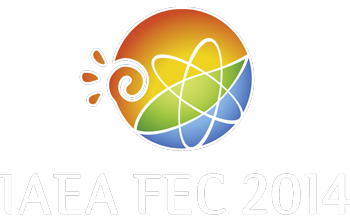Speaker
Mr
Joachim Herb
(Gesellschaft für Anlagen- und Reaktorsicherheit (GRS) mbH)
Description
During the last decades a safety concept for fusion power plants (FPP) has been developed which is based on the defence-in-depth safety concept of installations with radioactive inventories, especially nuclear fission power plants.
We present the main findings of a thorough literature study to reveal the current state of the fusion safety concept. The safety concept for FPPs like the concept for nuclear (fission) power plants (NPP) applies the concept of defence in depth. However, specific differences were identified between the implementations of the safety concepts due to the physical and technological characteristics of fusion and fission.
In safety concepts based on the concept of levels of defence, postulated initiating events (PIE) are identified and assigned to different levels of defence, covering the range from normal operation to very rare events.
We also examine the transferability of the current German nuclear fission safety requirements to the concepts of FPPs and especially the transferability of the fundamental safety function “confinement of the radioactive materials”, “cooling” and “reactivity control”.
Like in a NPP in a FPP measures and installations are foreseen to limit the consequences of PIEs to the radiological criteria of the applicable level of defence. Inherent physical principles, as well as passive and active safety systems are used for these measures and installations. Due to the current level of detail for the design of future FPP, the criteria for the measures and installations on the different levels of defence are not yet as detailed as for a fission power plant.
The safety analyses in the reviewed fusion literature have focused on plant-internal events. According to the current developments in the safety concepts of NPPs external hazards, e. g. earthquakes and flooding, or very rare human-induced hazards, e. g. the crash of a large air plane, have to be considered in safety analyses. These advanced requirements will also be applicable to future FPPs. Therefore, together with the development of more detailed plant concepts also events resulting from external hazards or very rare human-induced hazards have to be taken into account in more detail.
| Country or International Organisation | Germany |
|---|---|
| Paper Number | SEE/P5-12 |
Author
Mr
Joachim Herb
(Gesellschaft für Anlagen- und Reaktorsicherheit (GRS) mbH)
Co-authors
Dr
Arthur Weller
(Max-Planck-Institute for Plasma Physics)
Dr
Christoph Pistner
(Öko-Institut e.V. (Institute for Applied Ecology))
Mr
Dario Carloni
(Karlsruhe Institute of Technology (KIT))
Prof.
Jürgen Raeder
(Max-Planck-Institute for Plasma Physics)
Dr
Lorenzo Virgilio Boccaccini
(Karlsruhe Institute of Technology (KIT))
Prof.
Robert Stieglitz
(Karlsruhe Institute of Technology (KIT))
Prof.
Robert Wolf
(Max-Planck-Institute for Plasma Physics)
Dr
Xue Zhou Jin
(Karlsruhe Institute of Technology (KIT))

